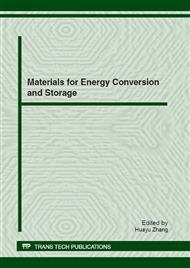[1]
G. Savage, Carbon-carbon composites, Chapman and Hall, London, 1993:p.85
Google Scholar
[2]
R. Naslain and F. Langlais, In tailoring multiphase and composite ceramics, Mater. Sci. Res. 20 (1986) 145-164.
DOI: 10.1007/978-1-4613-2233-7_12
Google Scholar
[3]
G.L. Vignoles, F. Langlais and A. Mouchon, CVD and CVI of pyrocarbon from various Precursors, Surface & Coatings Technology. 188/189 (2004) 241- 249.
DOI: 10.1016/j.surfcoat.2004.08.036
Google Scholar
[4]
A. Becker and K.J. Hüttinger, Chemistry and kinetics of chemical vapour deposition of pyrocarbon - ii, pyrocarbon deposition from ethylene, acetylene and 1,3 - butadiene in the low temperature regime, Carbon. 36 (1998) 177-199.
DOI: 10.1016/s0008-6223(97)00175-9
Google Scholar
[5]
A. Becker and K.J. Hüttinger, Chemistry and kinetics of chemical vapour deposition of pyrocarbon - iii, pyrocarbon deposition from propylene and benzene in the low temperature regime, Carbon, 36 (1998) 201-211.
DOI: 10.1016/s0008-6223(97)00176-0
Google Scholar
[6]
K. Norinaga and K.J. Hüttinger, Kinetics of surface reactions in carbon deposition from light hydrocarbons, Carbon, 41 (2003) 1509-1514.
DOI: 10.1016/s0008-6223(03)00097-6
Google Scholar
[7]
S. Vaidyaraman, W.J. Lackey, P. K. Agrawal and et al,Carbon/carbon processing by forced flow-thermal gradient chemical vapor infiltration using propylene, Carbon. 34 (1996) 347-362.
DOI: 10.1016/0008-6223(95)00190-5
Google Scholar
[8]
J. Xie, X .Wang, J. Deng and L. Zhang, Pore size control of pitch-based activated carbon fibers by pyrolytic deposition of propylene, Appl. Surf. Sci. 250 (2005) 152-160.
DOI: 10.1016/j.apsusc.2018.04.223
Google Scholar
[9]
X. Yao, K. Su, J. Deng, Gas-phase reaction thermodynamics im preparation of pyrolytic carbon by propylene pyrolysis, Computational Materials Science. 40 (2007) 504-524.
DOI: 10.1016/j.commatsci.2007.02.002
Google Scholar
[10]
H. Li, A. Li, R. Bai, K. Li, Carbon fiber reinforced silicon carbide matrix composite exhibits excellent mechanical properties, Carbon. 43 (2005) 2937-2950.
Google Scholar
[11]
S.Vaidyaraman, W.J. Lackey, P.K. Agrawal, T.L. Starr, 1-D Model for Forced Vapor Infiltration Process for Carbon, Carbon. 34 (1996) 1123-1133.
DOI: 10.1016/0008-6223(96)00086-3
Google Scholar
[12]
A, Becker, K.J. Hüttinger, Chemistry and kinetic of chemical vapor deposition of pyrocabon—V influece of reactor volume /deposition surface area ratio, Carbon. 36 (1998) 225-232.
DOI: 10.1016/s0008-6223(97)00178-4
Google Scholar
[13]
O. Feron, F. Langlais, R. Naslain, J. Thebault, The CVD of pyrocarbon from propane, Carbon. 37 (1999) 1343-1353.
DOI: 10.1016/s0008-6223(98)00329-7
Google Scholar


